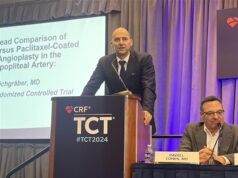
New data, just published in the Journal of the American Heart Association (JAHA), suggest that there is an increased risk of death at two and five years following the use of paclitaxel-coated balloons and stents in the femoropopliteal artery. While the authors, Konstantinos Katsanos (Patras, Greece) and colleagues, write in JAHA that this meta-analysis provides good statistical evidence to back these findings, some leading physicians state that it lacks individual patient-level data from the randomised controlled trials.
In the JAHA paper, the investigators write that several randomised controlled trials have already shown that paclitaxel-coated balloons and stents significantly reduce the rates of vessel restenosis and target lesion revascularisation after lower extremity interventions.
The investigators conducted a systematic review and meta-analysis of randomised controlled trials investigating paclitaxel-coated balloon angioplasty or paclitaxel-coated metal stents in the femoral and/or popliteal arteries. In all, 28 randomised controlled trials with 4,663 patients (89% intermittent claudication) were analysed. As reported in JAHA, they last screened medical databases, online content and regulatory authority filings in August 2018.
The primary safety measure was all-cause patient death, analysed at different time points. “Risk ratios and risk differences were pooled with a random effects model,” the authors write.
At one year, all-cause patient death (28 randomised controlled trials with 4,432 patients) was similar between 17 paclitaxel-coated devices and control arms (2.3% vs. 2.3% crude risk of death). All-cause death at two years (12 randomised controlled trials with 2,316 patients) was significantly increased in case of paclitaxel vs. control (7.2% [101 deaths in 1,397 patients] vs. 3.8% [35 deaths in 919 patients] crude risk of death, number-needed-to-harm [NNH]: 29 patients [95% CI: 19–59]). Long-term risk of all-cause death up to five years (three randomised controlled trials with 863 patients) increased further in case of paclitaxel (14.7% [78 deaths out in 529 patients] vs. 8.1% [27 deaths in 334 patients] crude risk of death, NNH: 14 patients [95% CI: 9–32]).
Katsanos and colleagues further write that meta-regression showed a significant relationship between exposure to paclitaxel (dose-time product) and absolute risk of death (0.4±0.1% excess risk of death per paclitaxel mg-year; p<0.001). “Trial sequential analysis excluded false-positive findings with 99% certainty (2-sided alpha, 1.0%),” they say.
These data led the authors to conclude that there is increased risk of death following application of paclitaxel-coated balloons and stents in the femoropopliteal artery. “Further investigations are urgently warranted,” they write.
Katsanos told Interventional News about the key data from the JAHA paper. “My colleagues and I have performed a meta-analysis of 28 studies comprising more than 4,600 patients (nearly 90% of these were claudicants) who were randomly allocated to either receive a paclitaxel-coated device (balloon or stent) in the femoropopliteal segment or a control non-drug-coated treatment. Our meta-analysis was restricted to well-designed randomised controlled trials alone to avoid comparing ‘apples’ with ‘oranges’. Statistical inference has identified an alarmingly higher rate of death after the first year in the case of the paclitaxel-coated device group; risk ratio 1.68 at two years and risk ratio 1.93 at four to five years of follow-up. Our findings were robust on multilevel sensitivity and subgroup analyses and we calculated that one out of 14 patients is expected to die because of paclitaxel up to five years (NNH=14).
“Overall, we would welcome collection and reporting of longer-term follow-up in case of all commercial clinical studies to help confirm, or refute our findings. It is also imperative to perform individual patient data time-to-event analysis for each individual device beyond the first year in combination with an in-depth query of potential confounders and predictors. To paraphrase one of Sherlock Holmes’ quotes: ‘When you have eliminated the impossible, whatever remains, however improbable, must be the truth’,” he said.
Interventional News collected early reaction on the dataset from key opinion leaders in the field.
Can the mortality risk be broken down by device type and make?

“The authors seem to have conducted a well-designed meta-analysis and subsequent statistical analysis of the incidence of mortality after the use of paclitaxel-coated stents and balloons in the lower extremity arteries. The authors’ findings are surprising, but on the evidence presented suggest that there may be an increased risk of death in the long term after patients have been treated with drug-coated devices. It would be interesting to know whether the authors found a significant difference in mortality between drug-coated balloons and stents. Also, did the authors find a relationship between mortality and the different types of devices? For example, how did the mortality risk play out with the Lutonix drug-coated balloon (DCB; BD) vs. IN.PACT DCB (Medtronic)?” questioned Robert Morgan (St George’s University Hospitals NHS Foundation Trust, London, UK, and president of the Cardiovascular and Interventional Radiological Society of Europe [CIRSE]).
“It is an obvious flaw of the data that causes of death were not uniformly recorded in the studies analysed. Despite the author’s rigorous statistical evaluation, there must still be a risk that the apparent increased mortality with these devices is due to other factors unrelated to paclitaxel. Clearly, the author’s findings suggest that more investigation is warranted into the potential mortal effects of paclitaxel-coated devices in the peripheral arteries. It is a matter of discussion whether all ongoing and future trials involving drug-eluting devices may require long-term, and even, life-long follow-up to look at the potential effects on mortality of these devices. It is a matter for conjecture whether if this were to be the case, the effect on industry’s enthusiasm to fund such trials might be tempered,” Morgan added.
Observation requires serious efforts to explain, but causes of death are crucial missing data

John Kaufman (Oregon Health and Science University, Oregon, USA, a past-president of the Society of Interventional Radiology [SIR] and the president of Vascular Interventional Advances [VIVA]) told Interventional News: “This is an observation that requires serious efforts to explain in the randomised controlled trials and examine in the real world, where these technologies are used with far greater frequency in critical limb ischaemia than the 11% represented in the trials. As the authors acknowledge, causes of death are the crucial missing data in the studies that were analysed; this information is necessary to determine whether there is causation in patients with claudication, and if so, to modify practice. As with everything we do, these still relatively new technologies should be used in a thoughtful manner in informed patients.”
Does this statistical mining of data bring to mind the fate of the COX-2 inhibitors?

Ziv Haskal (University of Virginia School of Medicine, Charlottesville, USA and editor-in-chief of the Journal of Vascular and Interventional Radiology [JVIR]) emphasised the importance of numbers. “Sometimes certain truths may only be suggested with the power of numbers. Katsanos et al have pooled and mined prospective comparative data on nearly 4,500 patients who underwent lower extremity revascularisation with and without local paclitaxel by balloon or stent. The stunning new observation of this sophisticated analysis is a nearly doubled rate of increased death at two and five years after intervention. This alarming finding brings to mind the similar means by which COX-2 inhibitors were first linked to increased cardiovascular mortality—notably, statistical findings were dismissed early on when they suggested a painful truth about these high value (and high margin) drugs. Now those medications have been withdrawn, or are used with very stringent consideration. As healthcare providers and scientists, we cannot fall prey to the urge to simply dismiss Katsanos et al’s findings and then focus on the next-presented, exciting, drug-coated device trial abstract. Long-term follow-up data must be mandated in all paclitaxel device trials, mechanistic studies must be undertaken, and replicative analyses considered. In the meanwhile, all physicians must consider the potential longer-term implications for their patients, when making treatment choices,” he said.
Investigate thoroughly—we have an earnest responsibility to inform and provide counsel to the patients we serve

Michael D Dake (University of Arizona, Tucson, USA and secretary of the SIR Executive Council) said: “The finding that paclitaxel-coated devices used in the femoropopliteal arteries of patients with peripheral arterial disease are associated with an increased risk of death after one year is surprising and clearly unanticipated. The most important response to this unexpected report is: why? In the absence of patient-level data from the randomised trials included in the meta-analysis, we are left grasping for explanations as to potential correlations and possible aetiological theories behind the stunning increase in all-cause death at two and five years in patients treated with paclitaxel-coated balloons and stents. The only sensible response is to join the authors’ concluding plea to support further investigations. These follow-up studies must include not only evaluations of the cause of death in the existing studies, but a thorough review of the meta-analysis methodology employed by the authors. Whenever shocking revelations challenge consensual understanding—especially when the unexpected reports concern serious issues of patient safety—the medical and regulatory communities have an obligation to move expeditiously in a coordinated manner to investigate the findings thoroughly and an earnest responsibility to inform and provide counsel to the patients we serve.”
Seeking a plausible mechanism for a possible link between the drug and mortality remote from the procedure

Gary Ansel (OhioHealth Heart and Vascular Physicians, Columbus, USA) told Interventional News: “As a physician and a scientist, I take patient safety very seriously. The authors certainly raise an important question using a meta-analysis in an attempt to link mortality rates to drug toxicity. The meta-analysis is handicapped by lack of patient-level data. Having been an investigator on many non-drug-based trials, it is curious that this association is being made with mortality rates that are very similar to those of the non-drug based technology trials (i.e, bare metal stents, control arms, uncoated percutaneous transluminal angioplasty). The current authors want an ‘urgent’ closer scrutiny of the devices included in the meta-analysis. Having presented on these devices to the Centers for Medicare and Medicaid Services (CMS) and the US Food and Drug Administration (FDA) I know that these agencies and the sponsors who develop and sponsor these technologies (i.e, Cook Medical, Medtronic and other companies) also take patient safety very seriously. I am somewhat surprised that the authors seem to ignore that an independent Clinical Events Committee reviewed all of the deaths in the IN.PACT SFA at the two-year follow-up point and found no link with the use of the paclitaxel-coated drug-coated balloon. As co-national principal investigator for the ZILVER PTX drug-eluting stent trial, a similar process was used for all patient deaths at five-years. The authors also do not offer any plausible mechanism for a possible link between the drug and mortality remote from the procedure. This underscores the importance of sponsors publishing the entirety of their data, at all follow-up periods, and making patient-level data available for independent analyses. These types of efforts should continue to have us look at long-term patient-level results for our procedures and I hope that the close evaluation will be the rule and not the exception.”
Watch the video interview with Konstantinos Katsanos on these breaking news findings.
Read the related commentary by Thomas Zeller.












